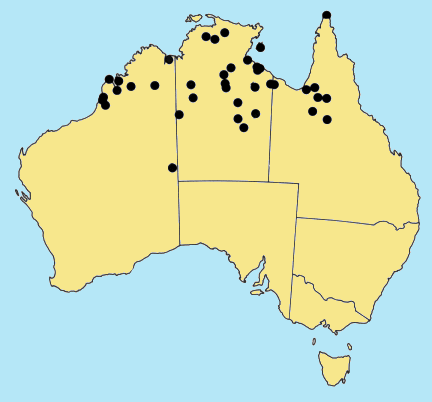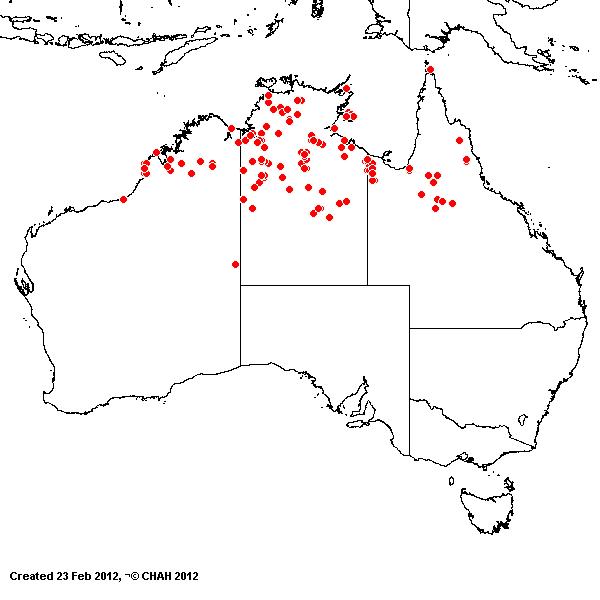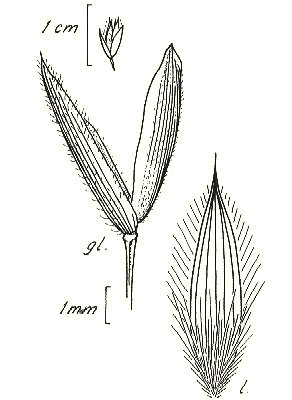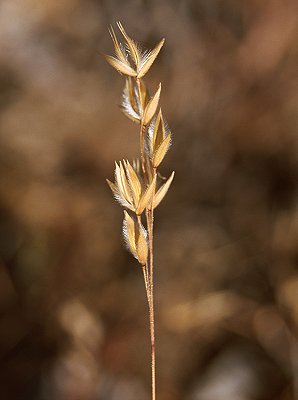Eriachne melicacea F. Muell. Fragm.
5: 205 (1866).
Classification. (GPWG 2001) : Subfamily
Micrairoideae. Eriachneae.
Type of Basionym or
Protologue Information: Australia, Victoria R.: Mueller (MEL holo, B, BR, K).
Key references
(books and floras): [1878] G.Bentham, Flora Australiensis 7 (631),
[1952] C.A.Gardner, Flora of Western Australia 1 Gramineae (52),
[1981] M.Lazarides in J.Jessop (ed)., Flora of Central Australia (443),
[2002] D.Sharp & B.K.Simon, AusGrass, Grasses of Australia.
Illustrations:
[1952] C.A.Gardner, Flora of Western Australia 1 Gramineae (47,
Pl. 12).
Habit. Annual
or perennial. Culms erect, 3–45.5 cm tall. Mid-culm nodes glabrous or
pubescent. Lateral branches simple or branched or fastigiate. Leaf-sheaths
hairy. Ligule a fringe of hairs. Leaf-blades 3–15 cm long, 1–2 mm wide.
Leaf-blade surface indumented.
Inflorescence.
Inflorescence compound, a panicle. Panicle linear, 1–5 cm long, 0.5–0.8 cm
wide.
Spikelets.
Spikelets pedicelled. Fertile spikelets 2-flowered, both fertile, comprising 2
fertile floret(s), without rachilla extension, ovate, laterally compressed, 7
mm long.
Glumes.
Glumes similar, thinner than fertile lemma. Lower glume ovate, membranous,
without keels, 11–13 -nerved. Lower glume surface glabrous or indumented. Upper
glume ovate, 4–8.3 mm long, membranous, without keels, 11–13 -nerved. Upper
glume surface smooth or tuberculate, glabrous or indumented.
Florets.
Fertile lemma (5.8–)6.8–7.3(–9) mm long, without keel, 5–7 -nerved. Lemma
surface indumented. Lemma apex muticous. Palea apex erose or dentate. Grain
3.8–4.8(–5.8) mm long.
Continental
Distribution: Australasia.
Australian
Distribution: Western Australia, Northern Territory, Queensland.
Western Australia:
Fitzgerald, Dampier. Mueller. Northern Territory: Darwin & Gulf,
Victoria River, Barkly Tableland, Central Australia North. Queensland:
Burke, Cook.
Notes.
The ciliate flaps of the palea in E. melicacea is an unusual feature in
the genus. Other distinguishing characters include the setaceous blades and
numerous sparse, linear panicles on elongated, filiform peduncles. Also, the
glumes are many-nerved and usually hispid or tubercled, the florets longer than
glumes and awnless, the lemmas long-ciliate on the margins, and the caryopsis
is thin, concave and long relative to the floret. Characteristically, the
glumes and lemmas are purple when young, and mature to a yellowish or straw
colour. Often, the lemma nerves are green and prominent in the developing
spikelet, but become colourless and less distinct with maturity and thickening
of the lemma. Eriachne melicacea closely resembles E. avenacea,
but is readily distinguished by its awnless spikelets. A noteworthy variant is
represented by Basedow 65 (BRI, K), Fitzgerald 522 (K, PERTH), Lazarides
3101 (CANB, K), 4786 (BRI, CANB, K), and Poulton s.n. (BM, K, L, MEL). These plants differ from
those in typical condition by their elongated florets that are longer than
glumes by 1.8–3 mm, their long lemmas (7.3–9 mm) and caryopses (4.5–5.8 mm),
and by their obtuse glumes.
Endemic.
Predominantly N of 22ºS in Qld, N.T. and W.A. Deep sands and loams on plains
and coastal dunes, skeletal and shallow often gravelly or stony soils in
association with granite, sandstone plateaux, quartzite hills and lateritic
rises, and seasonally wet usually sandy sites such as in and near streams,
depressions and swamps, which may be saline. Flowers and fruits Feb.-Sept.
(late-summer to early-spring).






